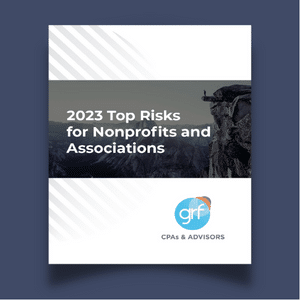February 2, 2023
As we look ahead to the new year and beyond, what are leading risk watchers expecting for 2023? The Risk and Advisory Services team at GRF combed through leading political, economic, and business experts’ predictions for 2023 to identify common themes and assess the implications for nonprofits and associations.
Major themes include:
We are entering an era of increased unpredictability and faster, more complex risks
A year ago, the phrase “the new normal,” was commonly used to describe expectations for 2022. This year, the word “normal” is largely absent. Nearly every risk report looking ahead to 2023 begins with a litany of disruptions and challenges organizations are facing: COVID-19 variants, inflation, higher interest rates, staffing shortages, cyberthreats, war in Ukraine, supply chain disruptions, increase in energy prices, political and social change, and more.
Staffing challenges will persist, and workplaces will continue to transform
Some of the most enduring impacts of the COVID-19 pandemic are workforce-related. The “Great Resignation” that began in 2021 has meant that the number of people leaving the workforce has outpaced people returning after losing or leaving their jobs during the initial shutdowns in 2020. The size of the labor force is expected to shrink further in the U.S. as a large percentage of workers reach retirement age. Additionally, there is increased turnover in all sectors as people seek to change their roles, industries, or working conditions.
Recession and cost increases will lead to more financial pressure
Cost-of-living increases and recessions will increase demand for many nonprofits’ services while simultaneously threatening their financial viability. The economic turmoil caused first by the pandemic, then policy responses to the pandemic, then exacerbated by the war in Ukraine, will not resolve soon. Interest rates are expected to increase worldwide as central banks fight inflation, which will likely trigger a global recession in 2023. Most expectations are that the recession will be relatively mild in the United States with recovery beginning by the end of the year. The downturn will be more severe for economies that are more vulnerable to the effects of the war in Ukraine and more dependent on energy and grain imports.
Technological advances increase cybersecurity and fraud threats
The quantity and breadth of malicious activity in cyberspace is proliferating and expected to expand at an even faster rate in 2023. Protracted war in Ukraine increases the likelihood of Russian cyberattacks, especially for organizations funded by the U.S. government and those that are active in supporting Ukraine. Cybercriminals are becoming more sophisticated and are increasingly targeting nonprofit organizations and associations, seeking to exploit vulnerabilities in their systems and networks. Organizations that rely on third-party service providers and have remote and hybrid work environments are at highest risk.
2023 Top Risks for Nonprofits and Associations provides GRF’s insight into how nonprofits and associations can address these threats. The appendices also include detailed summaries and links to the research reports referenced, including insights from The Enterprise Risk Management (ERM) Initiative at NC State University’s Poole College of Management, the World Economic Forum, the European Confederation of Institutes, The Economist Intelligence Unit, and more.

